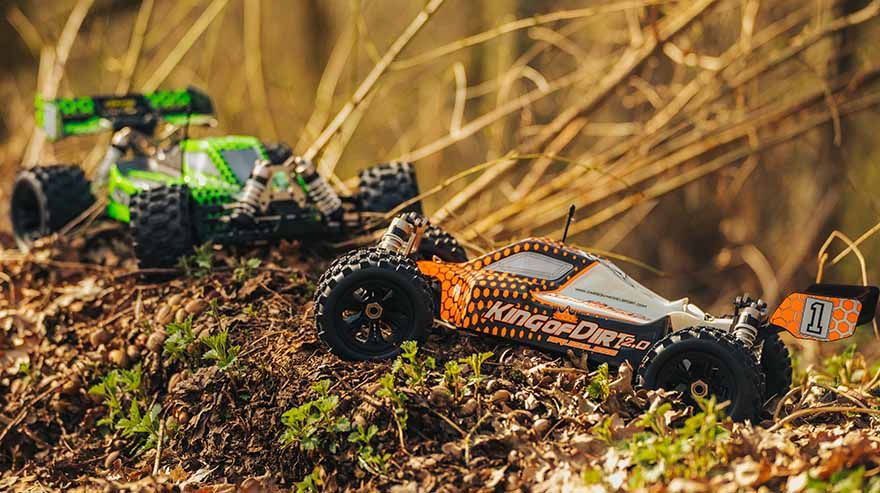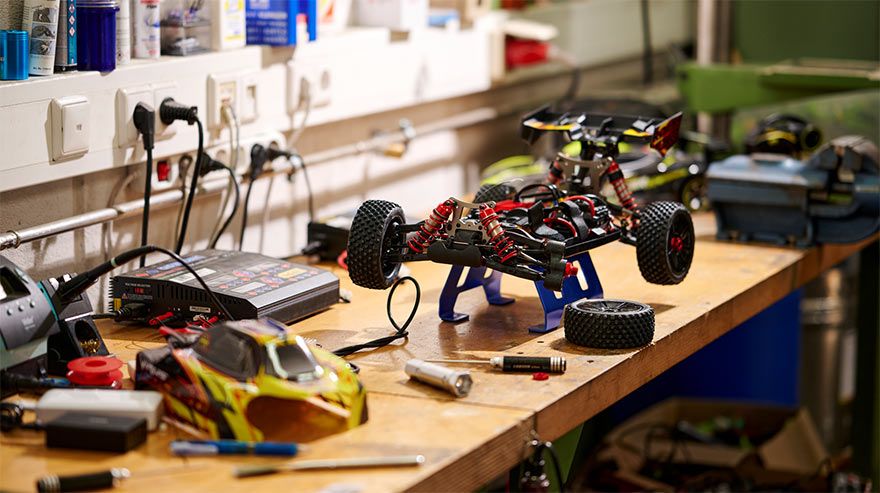Charging, storing and disposing of RC batteries correctly
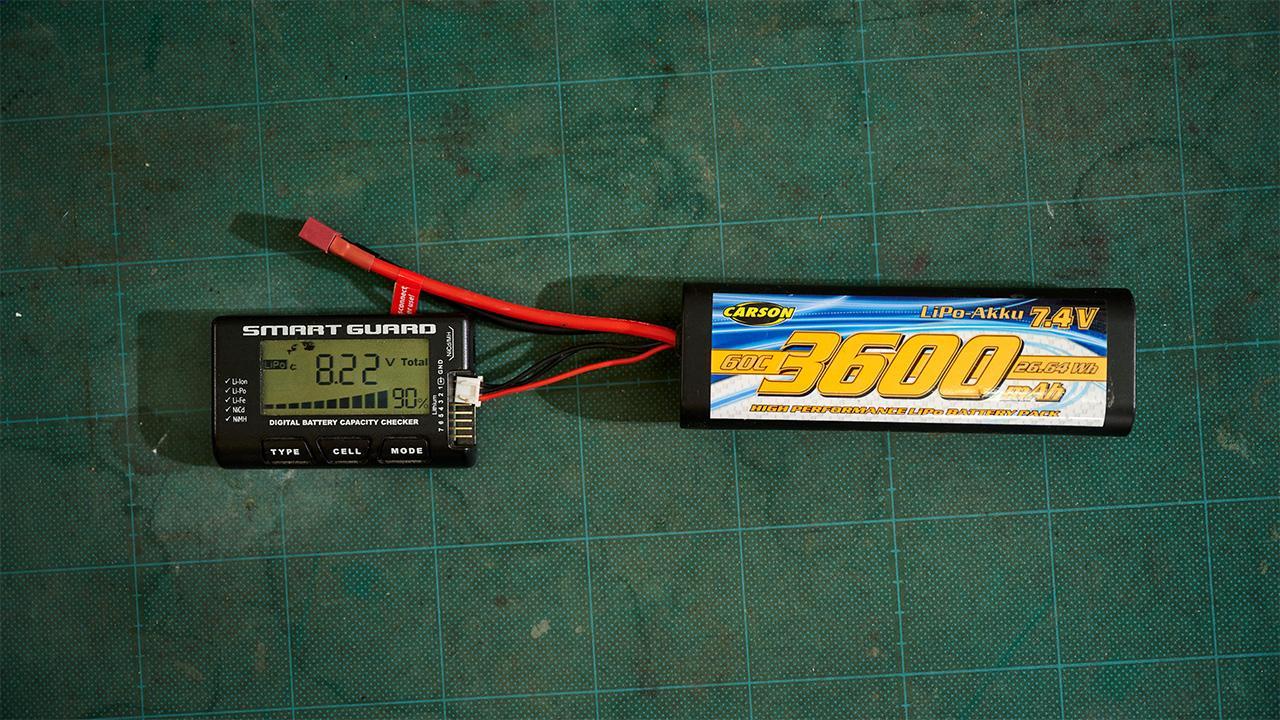
-
By
Oliver K.
How can you charge, store and dispose of RC rechargeable batteries and batteries correctly?
Strong, long-lasting rechargeable batteries and batteries ensure maximum driving fun. To ensure that your battery lasts as long as possible and does not lose power prematurely, it is important to charge it correctly. Note the differences that exist here depending on the battery type.
In the following article, you will learn how to charge your RC batteries correctly and what the differences are between the battery models.
What types of RC batteries are there?
There are three main types of battery. To charge RC batteries correctly, you need to know the specific battery type.
There are these battery types:
- LiPo batteries: lightweight, compact, high capacity, but relatively sensitive and expensive
- NiMh batteries: inexpensive, robust, slightly less power
- Li-ion batteries: immediately ready for use, powerful, very long-lasting
A LiPo (lithium polymer) battery is relatively compact compared to other variants and still offers a high capacity. The battery is lighter than a NiMh battery and has a higher capacity, but is more expensive and more sensitive.
NiMh (nickel-metal hydride) batteries are significantly cheaper and extremely robust, but less suitable for high performance. They are considered comparatively safe and are therefore suitable for use by children. Storage is also less complicated than with LiPo batteries; a separate fire protection bag is not necessary here.
The third variant is the Li-Ion (lithium-ion) batteryThis does not need to be charged before first use, but is ready for use immediately. The battery is also powerful and very durable.
At CARSON you will find various LiPo batteries, but also NiMH batteries and various Li-Ion batteries for your RC vehicles.
What needs to be considered when charging a LiPo battery
If you want your battery to last as long as possible, it is important to handle it correctly. In addition to the right charger, the type and method of charging and correct storage are also important.
You should therefore devote as much time to the topic of "charging RC batteries correctly" as you do to the care and maintenance of your RC vehicle. For all three battery types, it is important that you use a suitable charging cable and charger.
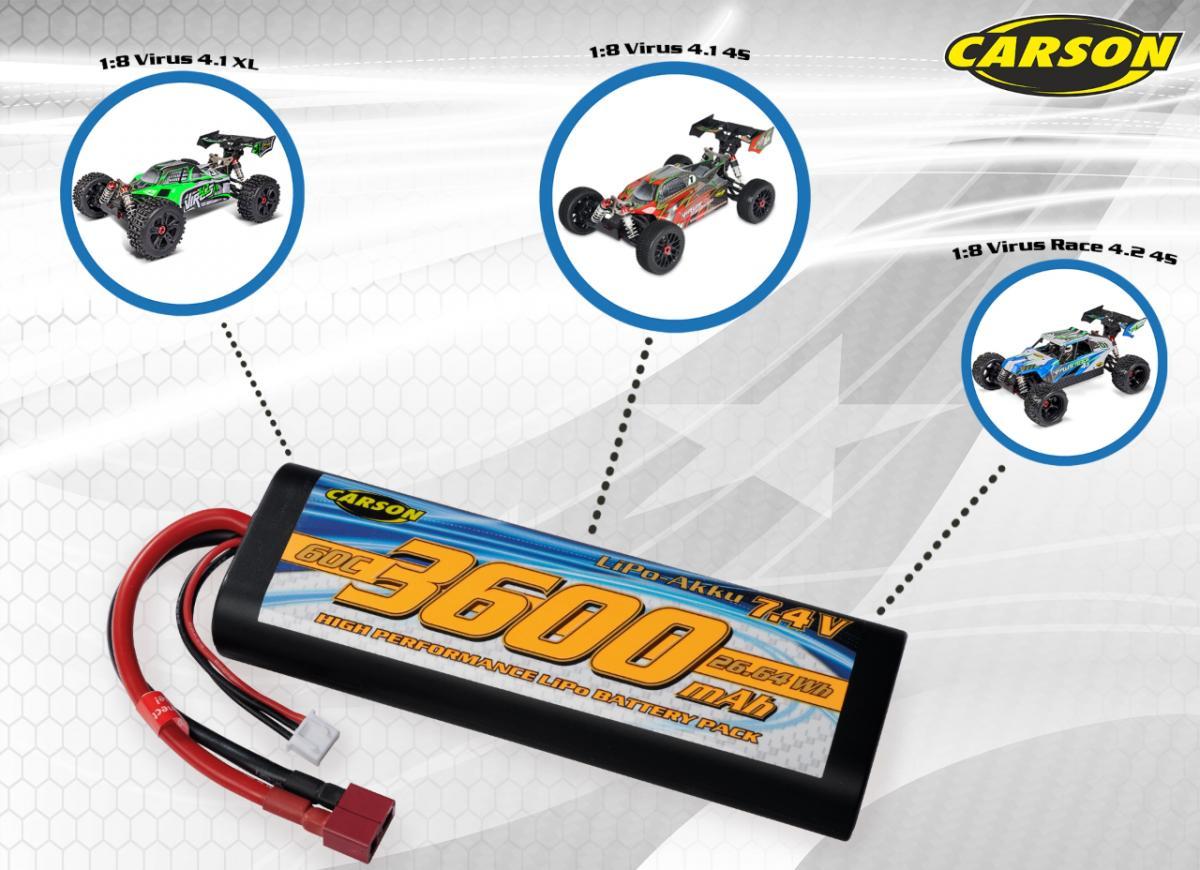
How to charge LiPo RC batteries correctly
Use a charger that is specially designed for LiPo batteries to charge your RC batteries correctly. If you handle your battery carefully and avoid overcharging, up to 600 charging cycles are possible without any problems. Before the first use, there is still no energy in the LiPo battery, but you have to charge it first.
The optimum charging current for your battery can be found either on the charger, its packaging or in the operating instructions. Pay particular attention to the values stated on the battery.
Use a fireproof battery case for storage and always keep your battery at the correct storage voltage. If possible, it should not be left completely empty or fully charged for longer than 14 days.
What must be observed when charging a NiMH battery
If you want to charge your NiMH battery correctly, the following things are important:
To charge a NiMH battery correctly, be particularly careful during the first charging cycles by using a low charging current. This type of battery only reaches its maximum capacity after three complete charging and discharging cycles. After that, the NiMH battery can also be charged with a higher charging current, so that you can finish charging much faster.
The best choice for this type of battery is a charger that automatically switches off as soon as the full charge level is reached. This prevents overcharging and damage to your battery. If the battery is not used for a longer period of time, a charge level of 50% and a room temperature of around 20°C are recommended. Recharging is necessary every two months to prevent the battery from discharging completely.
Tip: Slow charging is recommended every ten charging cycles, as this increases the service life of a NiMH battery. In addition, always allow your batteries to cool down completely before connecting them to the charger.
What must be observed when charging Li-lon RC batteries
There are also some rules to observe when handling Li-ion batteries if you want to charge RC batteries correctly.
You do not have to charge a Li-ion battery several times before using it for the first time, but it is usually ready for use immediately.However, you need a special charger for this type of battery and should use the battery regularly.
The ideal charge level for this type of battery is between 30 and 80 percent. When the Li-ion battery reaches a charge level of 10 to 20 percent, charge it. Do not wait until it is completely empty to maintain its long service life.
Store this type of battery at room temperature and never directly in the sun, as heat reduces performance and capacity. For a longer storage period, recharging is necessary every 12 months to avoid damaging the battery cells.
Tip: Dry, cool and never directly in the sun - correct storage is important for durability in addition to charging RC batteries correctly.
How should you store RC batteries correctly?
As already mentioned, the correct storage of rechargeable batteries and batteries is the basic prerequisite for ensuring that they can perform well for as long as possible. The ideal storage conditions differ from battery type to battery type. The same applies to the disposal of the products. There are also important differences in this respect that you should be aware of. In the following, you can get an overview and find out what you should pay attention to when charging or disposing of your battery.
Lithium-ion batteries
The lithium-ion battery is very popular as a model battery and is comparatively "easy to care for" when it comes to storage. To store the RC battery correctly, you first need a place that protects it from moisture and sunlight. This can be in a dry cellar, a garage or a well-insulated shed, for example. Important: Children should not have free access to the battery. It is therefore advisable to store it out of their reach, for example on a high shelf or in a lockable cupboard. The room temperature should also be taken into account: This should be between - 10° and + 50° for the lithium-ion battery, while the associated charging cables can only tolerate temperatures between + 5° and + 40°.
As far as the charge level is concerned, the RC battery should be partially discharged when stored. In other words: The battery should not be fully charged, but also not completely discharged. Ideally, there should be two illuminated LEDs on the RC battery.
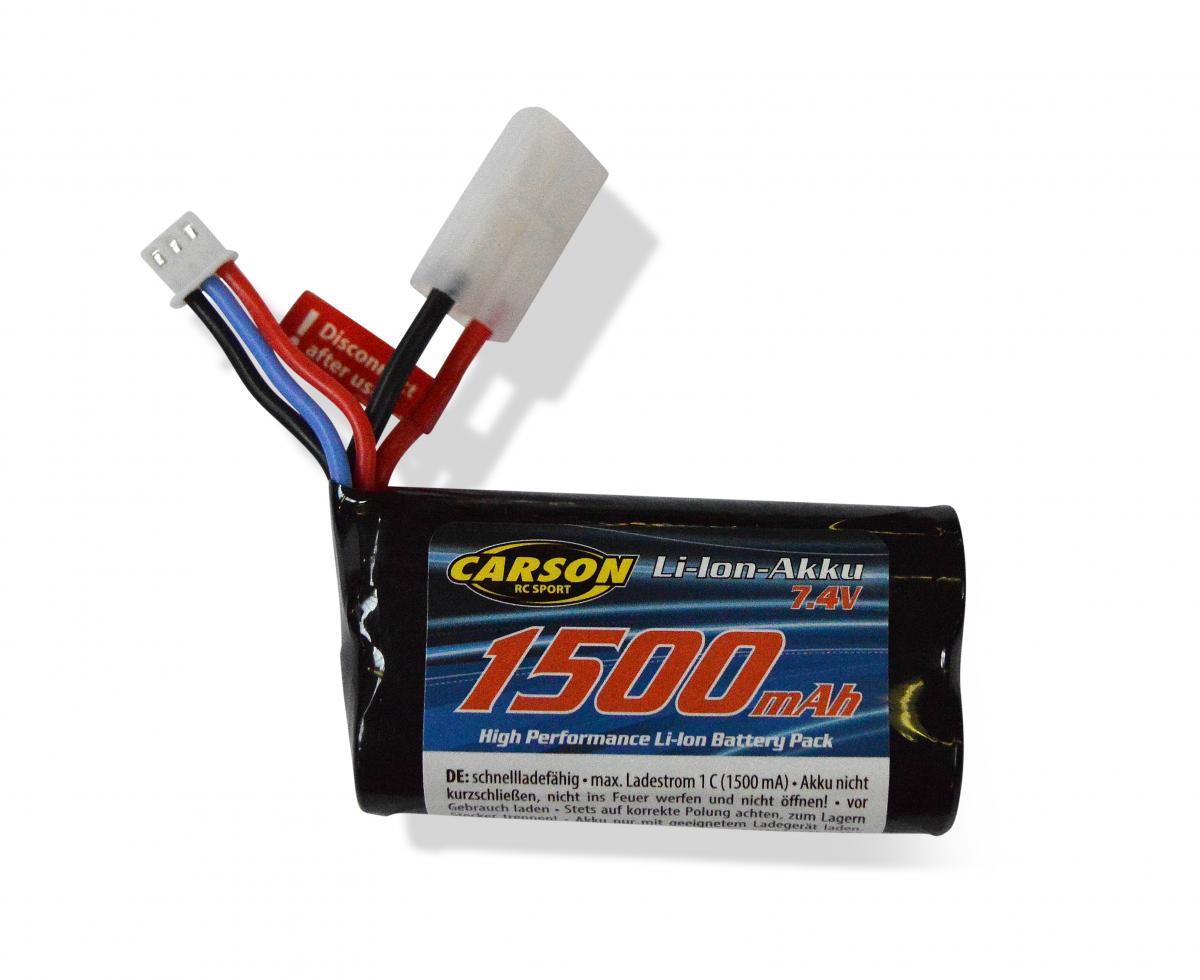
LiPo batteries
Attention: There is a risk of fire when storing LiPo batteries! It is therefore essential to store these RC batteries in a particularly safe place and also to transport them in compliance with appropriate safety precautions. For this very purpose, there are so-called LiPo bags, which are fireproof and offer excellent protection. Of course, these batteries should also be stored out of the reach of children.
If you want to store your LiPo battery for longer, you should bring it to storage voltage beforehand and then remember to check the voltage regularly. The charging capacity should always be between 10 % and 50 % during storage. It may therefore be necessary to recharge in between. This is because a deep discharge would permanently damage the battery
NiMH battery
Regular NiMH batteries have a self-discharge rate of 25% to 50% per month. RC batteries of this type should therefore be stored as fully charged as possible and their charge level should be checked regularly. A complete discharge and subsequent recharge is usually necessary every three to four months. You can ensure the maximum service life of these batteries by storing them at temperatures between +10° and +30°.
If you already know at the time of purchase that you want to store the NiMH RC battery for a long time, you should find out about Eco and LSD NiMH batteries. These have a significantly lower self-discharge rate of 10% to 15% per year.
Batteries
How long batteries last depends heavily on the manufacturer and the individual model. However, you can also have a positive influence on the shelf life and performance by storing them correctly. RC batteries are best stored in their original packaging, which protects them from humidity. They can be stored at room temperature, as long as this is fairly constant and the batteries are not exposed to direct sunlight. You should also note that batteries should not be stored in metal containers and should always be kept neatly separated according to their capacity. In other words, you should store old and new batteries separately
When should you dispose of a model building battery or an RC battery?
When it comes to the topic of "disposing of an RC battery correctly", the question arises as to when. There are some indications that you should dispose of your RC battery slowly:
- The performance decreases noticeably
- A greasy film forms
- The battery leaks
- You discover deformations
- The battery inflates
- The battery heats up excessively during use
Under no circumstances should you wait too long to dispose of your RC batteries and rechargeable batteries. After all, defective model batteries can cause fires, which is why: It's better to replace them too early than too late
How should you dispose of a lithium-ion battery
Do you want to dispose of your lithium-ion battery? Then you shouldn't even think about simply throwing it in the household waste. Proper disposal is the only way to protect the environment and recycle recyclable materials from the products. Pack the LiPo battery in a sealable plastic bag until disposal and take great care not to touch it with your bare hands. Why is that? Very simple: Leaking batteries can cause serious damage to the skin, even with very brief skin contact. In addition, you should cover the exposed contacts with adhesive tape to prevent short circuits.
RC Disposing of lithium-ion batteries - but where? In Germany, retailers of such batteries are legally obliged to take back the products for disposal. For lithium-ion batteries, the yellow collection boxes in stores are usually intended for this purpose. Alternatively, you can hand in the RC batteries at the disposal points of the public waste disposal companies, for example at the local recycling center.
How should you dispose of a LiPo battery?
If you want to dispose of a LiPo battery, you should fully discharge it beforehand to minimize the danger it poses. After all, such batteries can cause extremely dangerous fires and spontaneous explosions. Insulate the cables to prevent short circuits and stow the model battery in a fireproof container.
You can dispose of the battery - just like the lithium-ion batteries - in the collection box provided for this purpose at the retailer, DIY store or supermarket. If you need to dispose of a severely damaged RC LiPo battery, you should contact a model making or electronics retailer or a hazardous waste collection point or recycling center. These RC batteries also do not belong in household waste, but must be disposed of via retailers and stores with return boxes or alternatively via the recycling center. It is also advisable to pack the NiMH batteries safely in plastic and, as a precaution, not to touch them with unprotected hands
Conclusion: What you should bear in mind when charging, storing and disposing of RC batteries
In order for your model battery to last as long as possible, it is essential to handle it correctly. Depending on the battery type, different procedures are recommended for charging, storage and disposal. Always allow your battery to cool down after use before charging it again. Also ensure correct storage when the battery is not in use and dispose of it according to type.
To charge and store your RC batteries correctly, you need to know the exact type. This is because LiPo batteries, NiMH batteries and Li-ion batteries each require different procedures for charging, storage and disposal. High-quality chargers with automatic end-of-charge detection prevent overheating.
Here you will find our complete range of high-quality RC model batteries.
.














